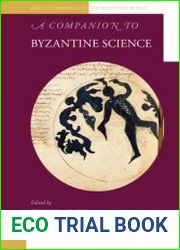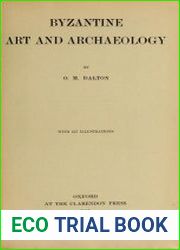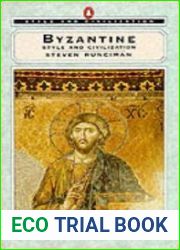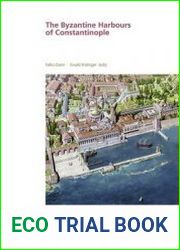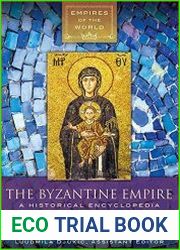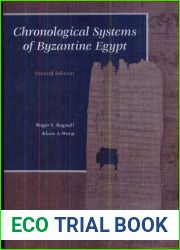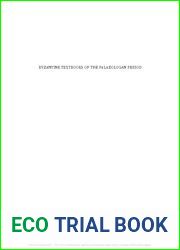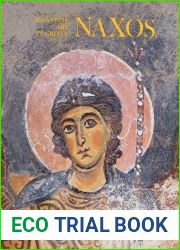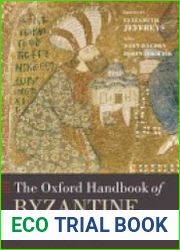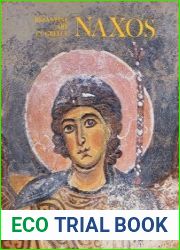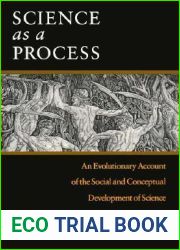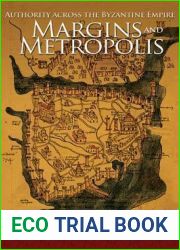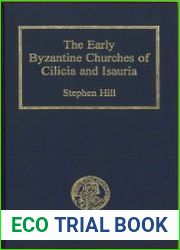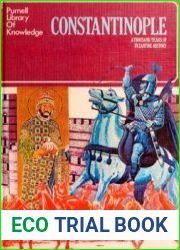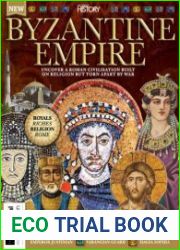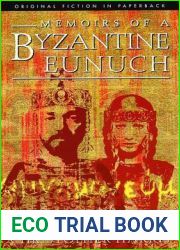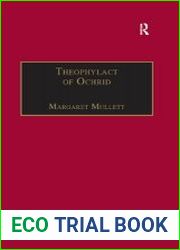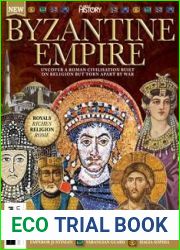
BOOKS - HISTORY - A Companion to Byzantine Science

A Companion to Byzantine Science
Author: Stavros Lazaris (ed.)
Year: 2020
Pages: 674
Format: PDF
File size: 17.2 MB
Language: ENG

Year: 2020
Pages: 674
Format: PDF
File size: 17.2 MB
Language: ENG

. The book A Companion to Byzantine Science provides a comprehensive overview of the scientific achievements and endeavors of the Byzantine Empire, spanning eleven centuries of history. The book is divided into three main sections, each one focusing on a different aspect of Byzantine science. The first section, "Science in Byzantium provides an introduction to the subject, discussing the historical context of science in the empire and how it was impacted by Christianization and education. The second section, "Survey of Scientific Disciplines delves into various scientific fields, including the exact sciences, natural sciences, medicine, and the occult sciences. The third section, "Vivacity and Diversity highlights the diverse and vibrant nature of Byzantine science, bringing it into broader conversations within Byzantine studies, medieval studies, and the history of science. The book begins with an introduction that sets the stage for understanding the development of science in the Byzantine Empire. This section covers the historical context of science in Byzantium, from its early beginnings to its influence on later civilizations. It also explores the relationship between Christianity and science in the empire and how these two forces shaped the teaching and practice of science throughout its history. This section provides a solid foundation for understanding the significance of Byzantine science and its place within the broader history of human knowledge. The second section, "Survey of Scientific Disciplines offers a comprehensive overview of the scientific disciplines cultivated in Byzantium. It begins with an examination of the exact sciences, such as geometry, arithmetic, and astronomy, which were fundamental to the empire's technological advancements.
.В книге A Companion to Byzantine Science представлен всесторонний обзор научных достижений и начинаний Византийской империи, охватывающий одиннадцать веков истории. Книга разделена на три основных раздела, каждый из которых фокусируется на различных аспектах византийской науки. Первый раздел, «Наука в Византии», содержит введение в предмет, обсуждая исторический контекст науки в империи и то, как на нее повлияли христианизация и образование. Второй раздел, «Обзор научных дисциплин», углубляется в различные научные области, включая точные науки, естественные науки, медицину и оккультные науки. Третий раздел, «Бодрость и разнообразие», освещает разнообразную и яркую природу византийской науки, привнося её в более широкие беседы в рамках византийских исследований, медиевистики и истории науки. Книга начинается с введения, которое закладывает основу для понимания развития науки в Византийской империи. Этот раздел охватывает исторический контекст науки в Византии, от ее ранних истоков до ее влияния на более поздние цивилизации. Он также исследует отношения между христианством и наукой в империи и то, как эти две силы формировали преподавание и практику науки на протяжении всей её истории. Этот раздел дает прочную основу для понимания значения византийской науки и ее места в более широкой истории человеческих знаний. Второй раздел, «Обзор научных дисциплин», предлагает всесторонний обзор научных дисциплин, культивируемых в Византии. Он начинается с изучения точных наук, таких как геометрия, арифметика и астрономия, которые были фундаментальными для технологический прогресс империи.
. livre A Companion to Byzantine Science présente un aperçu complet des réalisations scientifiques et des débuts de l'Empire byzantin, couvrant onze siècles d'histoire. livre est divisé en trois sections principales, chacune se concentrant sur différents aspects de la science byzantine. La première section, « La science à Byzantium », contient une introduction au sujet, discutant du contexte historique de la science dans l'empire et de la façon dont elle a été influencée par la christianisation et l'éducation. La deuxième section, « Examen des disciplines scientifiques », s'intéresse à divers domaines scientifiques, dont les sciences exactes, les sciences naturelles, la médecine et les sciences occultes. La troisième section, « La vivacité et la diversité », met en lumière la nature variée et lumineuse de la science byzantine, l'apportant à des conversations plus larges dans le cadre de la recherche byzantine, de la médiévologie et de l'histoire de la science. livre commence par une introduction qui pose les bases de la compréhension du développement de la science dans l'Empire byzantin. Cette section couvre le contexte historique de la science en Byzance, depuis ses origines antérieures jusqu'à son influence sur les civilisations ultérieures. Il explore également les relations entre le christianisme et la science dans l'empire et la façon dont ces deux forces ont façonné l'enseignement et la pratique de la science tout au long de son histoire. Cette section fournit une base solide pour comprendre l'importance de la science byzantine et sa place dans l'histoire plus large de la connaissance humaine. La deuxième section, « Examen des disciplines scientifiques », offre un aperçu complet des disciplines scientifiques cultivées à Byzantium. Il commence par étudier les sciences exactes telles que la géométrie, l'arithmétique et l'astronomie, qui étaient fondamentales pour le progrès technologique de l'empire.
libro A Companion to Byzantine Science ofrece una visión general completa de los avances científicos y los esfuerzos del Imperio bizantino, que abarca once siglos de historia. libro se divide en tres secciones principales, cada una de las cuales se centra en diferentes aspectos de la ciencia bizantina. La primera sección, «La ciencia en Bizancio», contiene una introducción al tema, discutiendo el contexto histórico de la ciencia en el imperio y cómo fue influenciada por la cristianización y la educación. La segunda sección, «Reseña de las disciplinas científicas», profundiza en diversos campos científicos, entre ellos las ciencias exactas, las ciencias naturales, la medicina y las ciencias ocultas. La tercera sección, «Vigor y diversidad», ilumina la naturaleza diversa y vibrante de la ciencia bizantina, llevándola a conversaciones más amplias dentro de los estudios bizantinos, la medievalidad y la historia de la ciencia. libro comienza con una introducción que sienta las bases para entender el desarrollo de la ciencia en el Imperio bizantino. Esta sección abarca el contexto histórico de la ciencia en Bizancio, desde sus primeros orígenes hasta su influencia en civilizaciones posteriores. También explora las relaciones entre el cristianismo y la ciencia en el imperio y cómo estas dos fuerzas han moldeado la enseñanza y la práctica de la ciencia a lo largo de su historia. Esta sección proporciona una base sólida para comprender la importancia de la ciencia bizantina y su lugar en la historia más amplia del conocimiento humano. La segunda sección, «Reseña de las disciplinas científicas», ofrece una visión global de las disciplinas científicas cultivadas en Bizancio. Comienza con el estudio de ciencias exactas como la geometría, la aritmética y la astronomía, que fueron fundamentales para el progreso tecnológico del imperio.
.O livro A Companion to Byzantine Science apresenta uma revisão completa dos avanços científicos e dos empreendimentos do Império Bizantino, que abrange onze séculos da história. O livro é dividido em três seções principais, cada uma focando em diferentes aspectos da ciência bizantina. A primeira seção, «Ciência em Bizântia», contém uma introdução ao tema, discutindo o contexto histórico da ciência no império e como a cristianização e a educação a influenciaram. A segunda seção, «Revisão de disciplinas científicas», aprofunda-se em várias áreas científicas, incluindo ciências exatas, ciências da natureza, medicina e ciências ocultas. A terceira seção, «Animação e diversidade», ilumina a natureza variada e brilhante da ciência bizantina, trazendo-a para conversas mais amplas como parte da pesquisa bizantina, da mídia e da história científica. O livro começa com uma introdução que estabelece as bases para a compreensão do desenvolvimento da ciência no Império Bizantino. Esta seção abrange o contexto histórico da ciência na Bizântia, desde suas origens iniciais até sua influência nas civilizações mais recentes. Ele também explora as relações entre o cristianismo e a ciência no império e como os dois poderes moldaram o ensino e a prática da ciência ao longo da sua história. Esta seção fornece uma base sólida para compreender o significado da ciência bizantina e seu lugar na história mais ampla do conhecimento humano. A segunda seção, «Revisão de disciplinas científicas», oferece uma revisão abrangente das disciplinas científicas cultivadas em Bizântia. Começa com o estudo de ciências exatas, tais como a geometria, aritmética e astronomia, que foram fundamentais para o progresso tecnológico do império.
.Il libro A Companion to Byzantine Science fornisce una panoramica completa dei progressi scientifici e degli inizi dell'impero bizantino, che copre undici secoli di storia. Il libro è suddiviso in tre sezioni principali, ognuna focalizzata su diversi aspetti della scienza bizantina. La prima sezione, «La scienza in Bizantia», contiene un'introduzione alla materia, discutendo del contesto storico della scienza nell'impero e di come la cristianizzazione e la formazione l'hanno influenzata. La seconda sezione, «La panoramica delle discipline scientifiche», si approfondisce in diverse aree scientifiche, tra cui le scienze esatte, le scienze naturali, la medicina e le scienze occulte. La terza sezione, «Vivacità e diversità», mette in luce la natura variegata e luminosa della scienza bizantina, introducendola in conversazioni più ampie nell'ambito della ricerca bizantina, della mediatica e della storia scientifica. Il libro inizia con un'introduzione che pone le basi per comprendere l'evoluzione della scienza nell'impero bizantino. Questa sezione copre il contesto storico della scienza in Bizantia, dalle sue origini iniziali alla sua influenza sulle civiltà successive. Egli esplora anche il rapporto tra il cristianesimo e la scienza nell'impero e il modo in cui queste due forze hanno formato l'insegnamento e la pratica della scienza nel corso della sua storia. Questa sezione fornisce una solida base per comprendere il significato della scienza bizantina e il suo posto nella storia più ampia della conoscenza umana. La seconda sezione, «Revisione delle discipline scientifiche», offre una panoramica completa delle discipline scientifiche coltivate a Bizantia. Inizia con lo studio di scienze precise, come geometria, aritmetica e astronomia, che erano fondamentali per il progresso tecnologico dell'impero.
.Das Buch A Companion to Byzantine Science bietet einen umfassenden Überblick über die wissenschaftlichen Errungenschaften und Anfänge des Byzantinischen Reiches und umfasst elf Jahrhunderte Geschichte. Das Buch ist in drei Hauptabschnitte unterteilt, die sich jeweils auf verschiedene Aspekte der byzantinischen Wissenschaft konzentrieren. Der erste Abschnitt, Wissenschaft in Byzanz, enthält eine Einführung in das Thema und diskutiert den historischen Kontext der Wissenschaft im Reich und wie sie von Christianisierung und Bildung beeinflusst wurde. Der zweite Abschnitt, „Überblick über die wissenschaftlichen Disziplinen“, vertieft sich in verschiedene wissenschaftliche Bereiche, darunter die exakten Wissenschaften, die Naturwissenschaften, die Medizin und die okkulten Wissenschaften. Der dritte Abschnitt, „Heiterkeit und Vielfalt“, beleuchtet die vielfältige und lebendige Natur der byzantinischen Wissenschaft und bringt sie in breitere Gespräche innerhalb der byzantinischen Studien, der Mediävistik und der Wissenschaftsgeschichte. Das Buch beginnt mit einer Einführung, die die Grundlage für das Verständnis der Entwicklung der Wissenschaft im Byzantinischen Reich legt. Dieser Abschnitt behandelt den historischen Kontext der Wissenschaft in Byzanz, von ihren frühen Anfängen bis zu ihren Auswirkungen auf spätere Zivilisationen. Es untersucht auch die Beziehung zwischen Christentum und Wissenschaft im Reich und wie diese beiden Kräfte die hre und Praxis der Wissenschaft im Laufe ihrer Geschichte geprägt haben. Dieser Abschnitt bietet eine solide Grundlage für das Verständnis der Bedeutung der byzantinischen Wissenschaft und ihres Platzes in der breiteren Geschichte des menschlichen Wissens. Der zweite Abschnitt, „Überblick über die wissenschaftlichen Disziplinen“, bietet einen umfassenden Überblick über die in Byzanz kultivierten wissenschaftlichen Disziplinen. Es beginnt mit dem Studium der exakten Wissenschaften wie Geometrie, Arithmetik und Astronomie, die für den technologischen Fortschritt des Reiches grundlegend waren.
. Książka A Companion to Bizantyjska Nauka zawiera kompleksowy przegląd dorobku naukowego i przedsięwzięć Imperium Bizantyjskiego, obejmujący jedenaście wieków historii. Książka podzielona jest na trzy główne sekcje, z których każda skupia się na różnych aspektach stypendium bizantyjskiego. Pierwsza część, „Nauka w Bizancjum”, zawiera wprowadzenie do tematu, omawiając historyczny kontekst nauki w imperium i jak wpłynął na nią chrystianizacja i edukacja. Druga sekcja, „Przegląd dyscyplin naukowych”, rozpoczyna się w różnych dziedzinach naukowych, w tym dokładnych nauk ścisłych, nauk przyrodniczych, medycyny i nauk okultystycznych. Trzecia sekcja, „Wigor i różnorodność”, podkreśla różnorodny i żywy charakter bizantyjskiej nauki, doprowadzając ją do szerszych rozmów w ramach bizantyjskich badań, średniowiecznych badań i historii nauki. Książka rozpoczyna się od wprowadzenia, które stanowi podstawę do zrozumienia rozwoju nauki w Imperium Bizantyjskim. Sekcja ta obejmuje historyczny kontekst nauki w Bizancjum, od jej wczesnych początków po wpływ na późniejsze cywilizacje. Bada również relacje między chrześcijaństwem a nauką w imperium i jak te dwie siły kształtowały nauczanie i praktykę nauki w całej jej historii. Sekcja ta stanowi solidną podstawę do zrozumienia znaczenia bizantyjskiej nauki i jej miejsca w szerszej historii ludzkiej wiedzy. Druga sekcja, „Przegląd dyscyplin naukowych”, oferuje kompleksowy przegląd dyscyplin naukowych uprawianych w Bizancjum. Rozpoczyna się od badań ścisłych nauk, takich jak geometria, arytmetyka i astronomia, które były fundamentalne dla postępu technologicznego imperium.
. הספר A Companion to Bizantian Science מספק סקירה מקיפה של ההישגים וההתחייבויות המדעיות של האימפריה הביזנטית, הספר מחולק לשלושה חלקים עיקריים, שכל אחד מהם מתמקד בהיבטים שונים של המלגה הביזנטית. החלק הראשון, ”מדע בביזנטיון”, מכיל מבוא לנושא, הדן בהקשר ההיסטורי של המדע באימפריה וכיצד הושפע מהנצרות והחינוך. החלק השני, Review of Scientific Disciplines, מתעמק בתחומים מדעיים שונים, כולל מדעים מדויקים, מדעי הטבע, רפואה ומדעי הנסתר. החלק השלישי, ”כוח וגיוון”, מדגיש את האופי המגוון והתוסס של המדע הביזנטי, ומביא אותו לשיחות רחבות יותר במסגרת המחקר הביזנטי, לימודי ימי הביניים וההיסטוריה של המדע. הספר מתחיל בהקדמה המניחה את היסודות להבנת התפתחות המדע באימפריה הביזנטית. סעיף זה מכסה את ההקשר ההיסטורי של המדע בביזנטיון, ממקורותיו המוקדמים ועד להשפעתו על תרבויות מאוחרות יותר. הוא גם בוחן את היחסים בין הנצרות לבין המדע באימפריה וכיצד שני כוחות אלה עיצבו את ההוראה והפרקטיקה של המדע לאורך ההיסטוריה שלה. סעיף זה מספק בסיס מוצק להבנת משמעות המדע הביזנטי ומקומו בהיסטוריה הרחבה יותר של הידע האנושי. החלק השני, Review of Scientific Disciplines, מציע סקירה מקיפה של הדיסציפלינות המדעיות שטופחו בביזנטיון. הוא מתחיל בחקר המדעים המדויקים כגון גאומטריה, אריתמטיקה ואסטרונומיה, שהיו בסיסיים להתקדמות הטכנולוגית של האימפריה.''
A Companion to Byzantine Science (Bizans Bilimine Bir Yol Arkadaşı) kitabı, on bir yüzyıllık tarihi kapsayan Bizans İmparatorluğu'nun bilimsel başarıları ve taahhütleri hakkında kapsamlı bir genel bakış sunar. Kitap, her biri Bizans bilginliğinin farklı yönlerine odaklanan üç ana bölüme ayrılmıştır. İlk bölüm olan "Bizans'ta Bilim", imparatorluktaki bilimin tarihsel bağlamını ve Hıristiyanlaşma ve eğitimden nasıl etkilendiğini tartışan konuya bir giriş içermektedir. İkinci bölüm, "Bilimsel Disiplinlerin Gözden Geçirilmesi", kesin bilimler, doğa bilimleri, tıp ve gizli bilimler de dahil olmak üzere çeşitli bilimsel alanlara girer. Üçüncü bölüm olan "Vigor ve Çeşitlilik", Bizans biliminin çeşitli ve canlı doğasını vurgulayarak, Bizans araştırmaları, ortaçağ çalışmaları ve bilim tarihi çerçevesinde daha geniş sohbetlere getiriyor. Kitap, Bizans İmparatorluğu'nda bilimin gelişimini anlamak için temel oluşturan bir giriş ile başlıyor. Bu bölüm, Bizans'taki bilimin tarihsel bağlamını, erken kökenlerinden sonraki medeniyetler üzerindeki etkisine kadar kapsar. Ayrıca, imparatorluktaki Hıristiyanlık ve bilim arasındaki ilişkiyi ve bu iki gücün tarih boyunca bilimin öğretimini ve uygulamasını nasıl şekillendirdiğini araştırıyor. Bu bölüm, Bizans biliminin anlamını ve insan bilgisinin daha geniş tarihindeki yerini anlamak için sağlam bir temel sağlar. İkinci bölüm, "Bilimsel Disiplinlerin Gözden Geçirilmesi", Bizans'ta yetiştirilen bilimsel disiplinlere kapsamlı bir genel bakış sunmaktadır. İmparatorluğun teknolojik ilerlemesi için temel olan geometri, aritmetik ve astronomi gibi kesin bilimlerin incelenmesiyle başlar.
. يقدم كتاب رفيق للعلوم البيزنطية نظرة عامة شاملة على الإنجازات العلمية والتعهدات التي حققتها الإمبراطورية البيزنطية، والتي تغطي أحد عشر قرنًا من التاريخ. ينقسم الكتاب إلى ثلاثة أقسام رئيسية، يركز كل منها على جوانب مختلفة من المنح الدراسية البيزنطية. يحتوي القسم الأول، «العلم في بيزنطة»، على مقدمة للموضوع، تناقش السياق التاريخي للعلوم في الإمبراطورية وكيف تأثر بالتنصير والتعليم. القسم الثاني، «مراجعة التخصصات العلمية»، يتعمق في مجالات علمية مختلفة، بما في ذلك العلوم الدقيقة والعلوم الطبيعية والطب والعلوم الغامضة. يسلط القسم الثالث، «Vigor and Diversity»، الضوء على الطبيعة المتنوعة والنابضة بالحياة للعلوم البيزنطية، مما يجعلها في محادثات أوسع في إطار الأبحاث البيزنطية ودراسات العصور الوسطى وتاريخ العلوم. يبدأ الكتاب بمقدمة تضع الأساس لفهم تطور العلم في الإمبراطورية البيزنطية. يغطي هذا القسم السياق التاريخي للعلوم في بيزنطة، من أصولها المبكرة إلى تأثيرها على الحضارات اللاحقة. كما يستكشف العلاقة بين المسيحية والعلوم في الإمبراطورية وكيف شكلت هاتان القوتان تدريس وممارسة العلم عبر تاريخها. يوفر هذا القسم أساسًا متينًا لفهم معنى العلم البيزنطي ومكانته في تاريخ المعرفة البشرية الأوسع. ويقدم القسم الثاني المعنون «استعراض التخصصات العلمية» لمحة عامة شاملة عن التخصصات العلمية المزروعة في بيزنطة. يبدأ بدراسة العلوم الدقيقة مثل الهندسة والحساب وعلم الفلك، والتي كانت أساسية للتقدم التكنولوجي للإمبراطورية.
책 비잔틴 과학과의 동반자는 11 세기의 역사를 다루는 비잔틴 제국의 과학적 업적과 사업에 대한 포괄적 인 개요를 제공합니다. 이 책은 비잔틴 장학금의 여러 측면에 중점을 둔 세 가지 주요 섹션으로 나뉩니다. 첫 번째 섹션 인 "비잔티움의 과학" 에는 제국의 과학의 역사적 맥락과 그것이 기독교화와 교육에 의해 어떻게 영향을 받는지에 대한 주제에 대한 소개가 포함되어 있습니다. 두 번째 섹션 인 "과학 분야 검토" 는 정확한 과학, 자연 과학, 의학 및 신비 과학을 포함한 다양한 과학 분야를 탐구합니다. 세 번째 섹션 인 "Vigor and Diversity" 는 비잔틴 과학의 다양하고 활기찬 본질을 강조하여 비잔틴 연구, 중세 연구 및 과학의 역사에서 더 넓은 대화를 가져옵니다. 이 책은 비잔틴 제국의 과학 발전을 이해하기위한 토대를 마련하는 소개로 시작됩니다. 이 섹션은 초기 기원에서 후기 문명에 대한 영향에 이르기까지 비잔티움의 과학의 역사적 맥락을 다룹니다. 그는 또한 제국의 기독교와 과학의 관계와이 두 세력이 역사 전반에 걸쳐 과학의 가르침과 실천을 어떻게 형성했는지 탐구합니다. 이 섹션은 비잔틴 과학의 의미와 더 넓은 인간 지식 역사에서의 위치를 이해하기위한 확실한 기초를 제공합니다. 두 번째 섹션 인 "과학 분야 검토" 는 비잔티움에서 재배 된 과학 분야에 대한 포괄적 인 개요를 제공합니다. 그것은 제국의 기술 발전의 기초가 된 기하학, 산술 및 천문학과 같은 정확한 과학에 대한 연구로 시작됩니다.
。The本A Companion to Byzantine Scienceは、11世紀の歴史をカバーし、ビザンチン帝国の科学的業績と取り組みの包括的な概要を提供しています。本は3つの主要なセクションに分かれており、それぞれがビザンチン奨学金のさまざまな側面に焦点を当てています。第1部の「サイエンス・イン・ビザンチウム」には、帝国における科学の歴史的文脈と、それがキリスト教化と教育にどのように影響されたかを論じた主題の紹介が含まれています。第2部「科学分野の見直し」では、正確な科学、自然科学、医学、オカルト科学など、さまざまな科学分野を掘り下げます。第3部「活気と多様性」では、ビザンチン科学の多様で活気に満ちた性質を強調し、ビザンチン研究、中世研究、科学史の枠組みの中で、より幅広い議論をもたらします。この本は、ビザンチン帝国における科学の発展を理解するための基礎を築く紹介から始まります。このセクションでは、ビザンチウムの科学の歴史的な文脈について説明します。彼はまた、帝国におけるキリスト教と科学の関係と、これら2つの勢力が、その歴史を通して科学の教えと実践をどのように形成したかを探求している。このセクションは、人間の知識の広い歴史におけるビザンチン科学とその場所の意味を理解するための確かな基礎を提供します。2番目のセクション「科学分野のレビュー」では、ビザンチウムで栽培された科学分野の包括的な概要を提供しています。それは、帝国の技術進歩の基本であった幾何学、算術、天文学などの正確な科学の研究から始まります。







